
Research Results
ICT Application and Integration by Pre-service Teachers Beginning to Implement the IMYM Model
Prepared by Distance Learning and Information Technologies Unit, Program Development Branch, Manitoba Education and Early Childhood Learning
Analysis of Pre-service Teachers' Self-reported Skills in Using ICT Applications
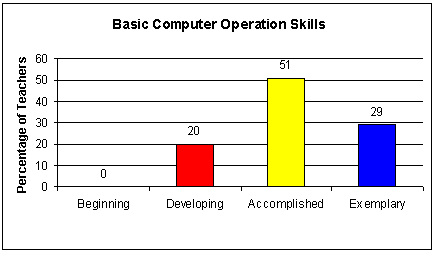
All of the pre-service teachers identify themselves as already possessing some skills in basic computer operation (see Appendix A Part I). More than half of pre-service teachers rate themselves at the Accomplished level. At the Accomplished level, these teacher candidates can set-up computer and peripheral devices, as well as load software, print, and use most of the operating system tools such as the scrapbook, clock, find command, and trash can. They can also run two programs simultaneously and have several windows open at the same time. More pre-service teachers rate themselves at the Exemplary level for this skill than for any other ICT literacy skill.
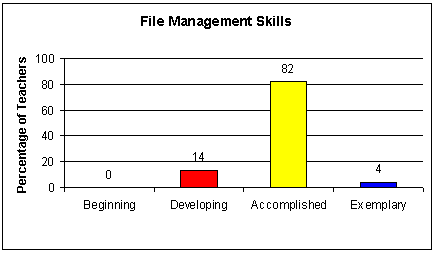
Eighty-two percent of pre-service teachers identify themselves at the Accomplished level in file management skills (see Appendix A Part II). At this level, these teacher candidates have a filing system for organizing their electronic files quickly and reliably. They also back up their files on a regular basis. More pre-service teachers rate themselves at the Accomplished level for this skill than for any other ICT literacy skill.
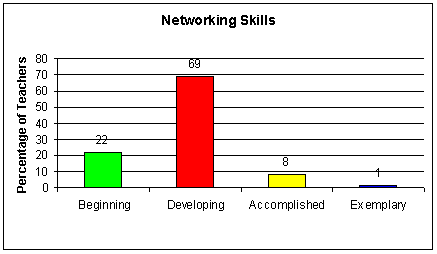
Most pre-service teachers (69%) place themselves at the Developing level for networking skills (see Appendix A Part III). At this level, they can use a computer network to store files and to access a printer. Almost one-quarter of teacher candidates (22%) have no knowledge of computer network operation (Beginning level). More pre-service teachers rate themselves at the Developing level for this skill than for any other ICT literacy skill.
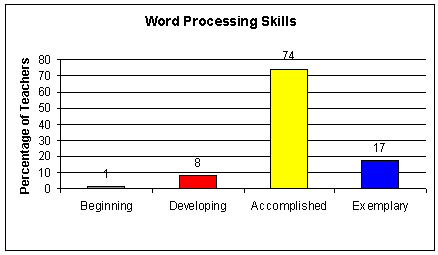
Most of the pre-service teachers (74%) identify themselves at the Accomplished level for word processing skills (see Appendix A Part IV). At this level, these teacher candidates use a word processor for nearly all their written professional work and home communication, can edit, spell check, and change the format of a document. At the Exemplary level seventeen percent of the pre-service teachers agree that they use the word processor not only for their own work, as described in the Accomplished level, but also have taught students to use it for all stages of the writing process.
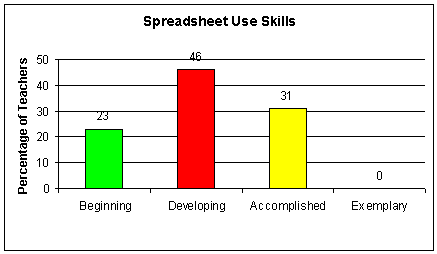
Sixty-nine percent of pre-service teachers place themselves either at the Beginning or Developing levels of spreadsheet use skills (see Appendix A Part V). These teacher candidates either have never used a spreadsheet, or can create only a simple spreadsheet that adds a column of numbers used to keep track of student grades. Almost one third of pre-service teachers (31%) indicate that they are able to use labels, formulas and cell references in their spreadsheets. They can also change the format by changing column widths and text style and make a simple graph or chart.
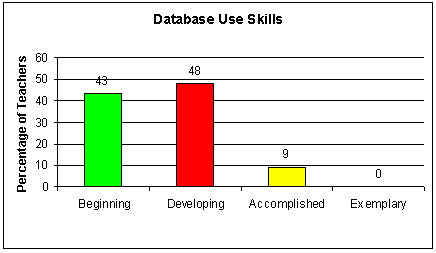
Forty-three percent of the pre-service teachers place themselves at the Beginning level of database use skills (see Appendix A Part VI). These pre-service teachers have never used a database. Almost half of the pre-service teachers rate themselves at the Developing level. These teacher candidates understand the use of a database and can locate information within one that has been pre-made. They can also add or delete data and can sort and print the information in layouts that are useful to them.
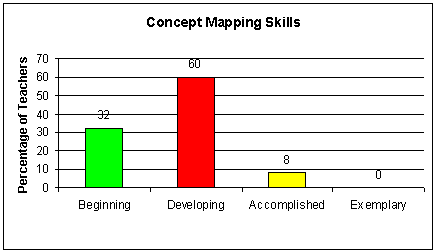
Most pre-service teachers (92%) place themselves at either the Beginning or Developing level of electronic concept mapping skills (see Appendix A Part VII). These teacher candidates either do not use concept mapping software or they understand how to use concept mapping software only for creating simple concept maps and outlines in preparation for writing. Less than 10% of pre-service teachers know how to use concept mapping software as a note-taking and organizational tool or to customize the symbols, links and layout of their concept maps.
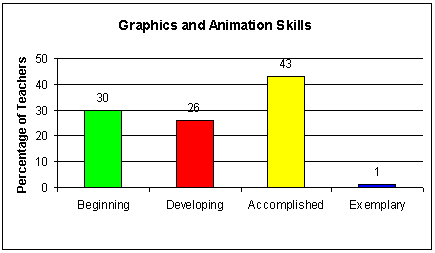
Nearly half of the pre-service teachers (43%) place themselves at the Accomplished level for graphics/animation skills (see Appendix A Part VIII). At the Accomplished level, these teacher candidates can use clipart and can create simple original graphics in paint, draw, and word processing applications. They can also edit clipart, apply drawing tools, and use the clipboard to take graphics from one application for use in another. Of the remaining pre-service teachers, more than half do not use graphics in their word processing or presentations (Beginning level) or can create only simple graphics with paint and draw programs (Developing level).
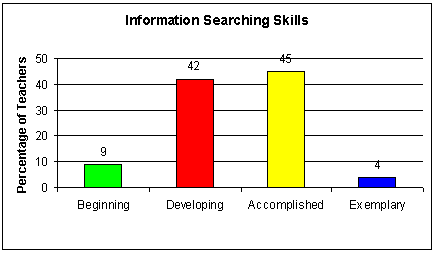
Forty-two percent of the pre-service teachers identify themselves at the Developing level for information searching skills (see Appendix A Part IX). At the Developing level, teacher candidates can conduct simple searches with electronic encyclopedias and library software for major topics. Almost half (45%) are able to conduct more complex searches using Boolean (logical) operators such as 'and' 'or' (Accomplished level).
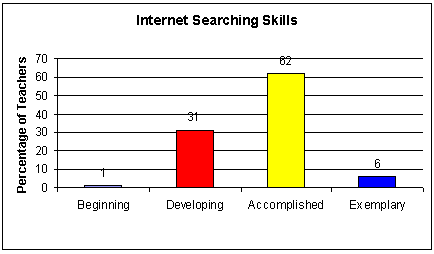
Almost two thirds of pre-service teachers (62%) place themselves at the Accomplished level for Internet searching skills (see Appendix A Part X). These teacher candidates are able to make efficient use of a variety of search engines as well as use lists of Internet resources to explore educational applications of the Internet. They can evaluate the source of information and its URL, to assess validity. Of the remaining teachers, almost one third (31%) can use a web browser but spend little time doing so (Developing level).
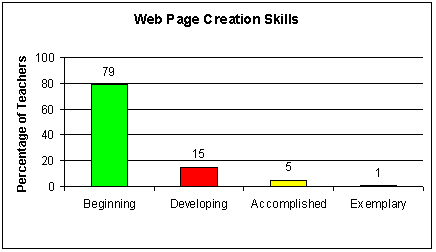
Most pre-service teachers (79%) identify themselves at the Beginning level of web page creation skills (see Appendix A Part XI). These teacher candidates have never created a web page. More pre-service teachers rate themselves at the Beginning level for this skill than for any other ICT literacy skill. Only fifteen percent of pre-service teachers have created a simple single web page with graphics and Internet and mail-to links (Developing level).
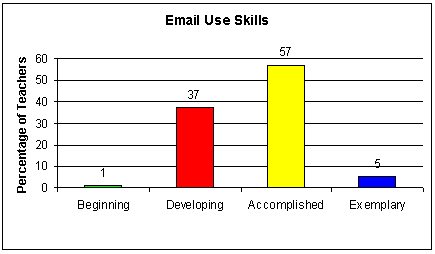
Over half of the pre-service teachers (57%) place themselves at the Accomplished level for email use skills (see Appendix A Part XII). These teacher candidates check their email account on a regular basis. They also use email to access professional information from listservs, and participate in online discussions. Other pre-service teachers (37%) understand that there is a large quantity of information available to them via electronic mail but only occasionally send messages or make requests for information by electronic mail (Developing level).
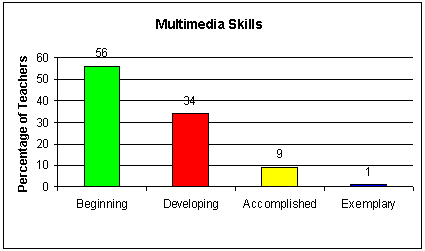
Almost all pre-service teachers (90%) place themselves at either the Beginning or Developing level of multimedia skills (see Appendix A Part XIII). These teacher candidates have either never created their own multimedia presentation (Beginning level) or they were able to create only a simple multimedia presentation integrating text and graphics (Developing level). Less than ten percent have authored multimedia presentations that include actions, animations, audio, and video (Accomplished level).
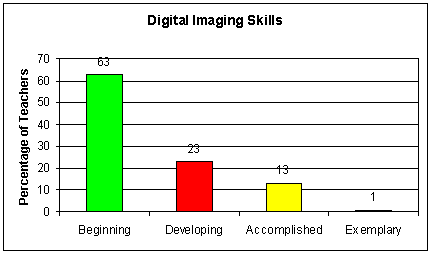
Nearly two thirds of pre-service teachers place themselves at the Beginning level of digital imaging skills and have never connected a digital camera to a television or to a computer (see Appendix A Part XIV). Twenty-three percent of teacher candidates could connect a digital camera to a computer to download digital images and could alter these images by cropping, rotating and resizing (Developing level). A few pre-service teachers (13%) were able to import digital images into word processing documents, concept maps and multimedia presentations (Accomplished level).
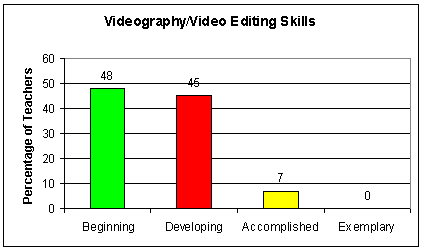
Nearly half the pre-service teachers place themselves at the Beginning level (48%) of videography/video editing skills (see Appendix A Part XV). At the Beginning level, most teacher candidates have never connected a digital camera to a VCR, television, or computer. However, many pre-service teachers (45%) have connected a video camera and VCR to a televison in order to display the video image on the TV monitor (Developing level).


